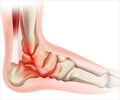- Sprained ankle - (http://www.mayoclinic.org/diseases-conditions/sprained-ankle/basics/definition/con-20032428)
- Ankle Sprain - (http://www.webmd.com/a-to-z-guides/ankle-sprain-overview)
- About Sprained ankle - (http://en.wikipedia.org/wiki/sprained_ankle)
About
Ankle sprains occur when the ligaments that hold the ankle bones together get stretched or torn. This happens when the ankle is rolled, twisted or turned awkwardly.
A sprained ankle is an injury that is caused when the ligaments that hold the ankle bones together get stretched or torn. This injury usually occurs when the ankle is rolled, twisted or turned awkwardly.
Ligaments are bands of tissue that play a role in stabilizing and holding joints together thereby preventing excessive movement. A sprain in the ankle occurs when the ligaments are forced to exceed beyond their normal range of motion. It is common to find the ligaments on the outer side of the ankle being impaired when a sprain occurs.
Most people experience an ankle twist at some point in their life. In case the ankle gets swollen, and there is a lot of pain, you may suspect an ankle sprain and possibly, a tear in the ligaments.
Although common, sprained ankles must not be considered as minor injuries. It is very important to treat them to prevent chronic problems or later-life complications.
Ankle sprains may be categorized as grade 1, 2, and 3.They may be classified from mild to severe depending on the damage and the number of ligaments that are involved in the injury.
Grade 1 - Mild sprain involves very little damage to a ligament without causing instability in the affected joint. Ankle may be tender, swollen and stiff but the leg is stable and walking is possible
Grade 2 - Moderate sprain involves partial tear of ligament. Bruising and tenderness around the ankle will make walking painful
Grade 3 - Severe sprain involves complete ligament tear, causing instability in the affected joint. The ankle is unstable and will feel "wobbly." Walking is impossible and the pain would be severe.
Types of ankle sprain -
a) Inversion (lateral) ankle sprain - This type comprises of 70- 85% of all ankle sprains and occurs when the foot is inverted or turned inward considerably, affecting the outer side of the foot besides damaging the anterior talofibular and calcaneofibular ligaments.
b) Eversion ankle sprain - This is a less common type of ankle sprain which affects the inner side of the foot, damaging or stretching the medial (deltoid ) ligament.
c) High ankle sprain - This is an injury to the large ligaments above the ankle that connect the two long bones (tibia and fibula) of the lower leg. High ankle sprains commonly occur to those playing contact sports such as football, rugby, basketball, baseball, volleyball, frisbee and other games such as tennis, badminton and horse riding. High ankle sprains occurs when the foot is suddenly and forcefully twisted outward.







